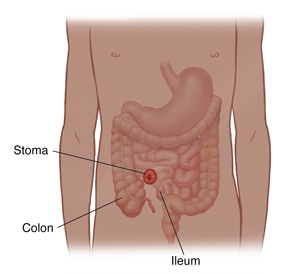Content
After Your Child’s Ileostomy
Your child had a procedure called an ileostomy. This surgery affects part of the large intestine called the colon and part of the last section of the small intestine called the ileum. Parts of your child’s colon and ileum were cut. They may have been removed. A small hole called a stoma has been made in the abdominal wall and skin. During surgery, the intestine was attached to the skin. This allows stool and mucus to pass out of the body. The stool and mucus drain into a bag. The ileostomy stool is loose and not formed.
Below are guidelines for home care after an ileostomy. The healthcare staff may give you other directions for your child. A specially trained nurse called a wound-ostomy-continence nurse may talk with you to go over questions and care.
Home care
After surgery, make sure to:
Care for your child’s stoma as directed.
Keep the surgery incisions clean and dry.
Check the incisions every day. Look for redness, leaking fluid, swelling, or edges that pull apart.
Follow all directions about watching the amount of output into the ileostomy bag.
Give your child any prescribed medicines and vitamins as directed. Don’t skip doses.
Don’t give your child over-the-counter medicines unless the healthcare provider says it’s OK.
In addition:
Your child can shower or bathe as needed. Don’t let the incisions soak under water. When it’s time to wash the incision, gently clean them with soap and water and pat dry.
Keep your child from lifting anything heavier than
5 pounds until the healthcare provider says it’s OK.Keep your child from rough play and contact sports. But you can let your child be active, such as taking walks. If traveling in a car for long periods, stop often to let your child move around.
Ask the healthcare provider when your child can return to school. Most children are able to within
2 to 3 weeks after surgery.
Living with a stoma
Your child’s stoma may be for a short time (temporary) or permanent. During this time, keep in mind:
An ileostomy bag doesn’t smell. And it can be hidden under clothing.
Tell your child’s teachers and the school nurse that your child has an ileostomy.
The bag can be emptied into a toilet in privacy. Work with school or other caregivers to help your child as needed.
A child with an ileostomy can still play most sports. Talk to your child’s healthcare provider about physical activity that is OK for your child.
Follow-up care
Make follow-up appointments as advised.
When to call the healthcare provider
Call the healthcare provider right away if any of the following occur:
Excess bleeding from the stoma
Bulging skin around the stoma
Fever of
100.4 °F (38.0 °C) or higher, or as directed by the healthcare providerRedness, swelling, bleeding, or fluid from the incision or the stoma
Signs of dehydration, such as dry mouth, little urine, or no tears when crying
Change in the color or size of the stoma
Too much waste output from the stoma
Bloody or black, tarry stool
Stool that is more watery than normal for more than
5 hoursNo gas or stool leaving the stoma
Nausea, vomiting, pain, cramping, or bloating
Weight loss


